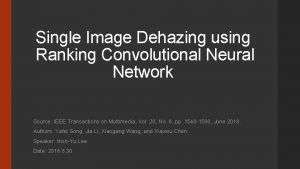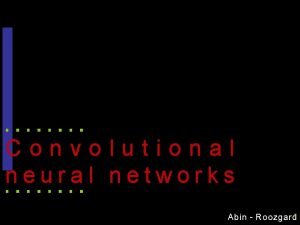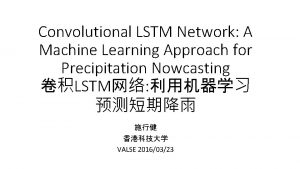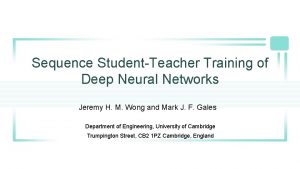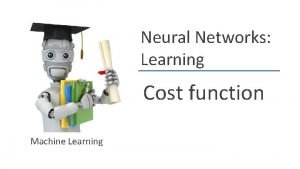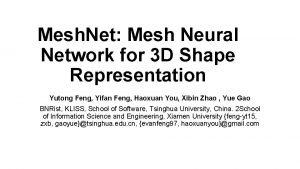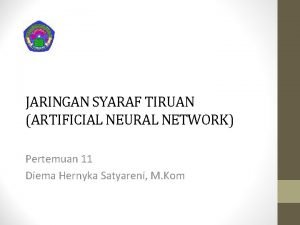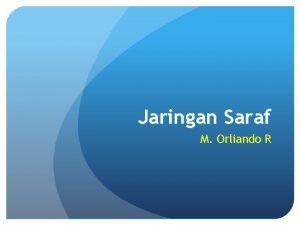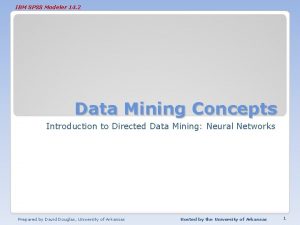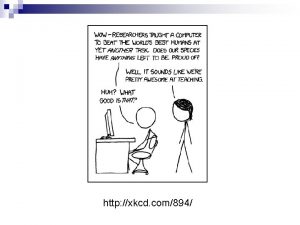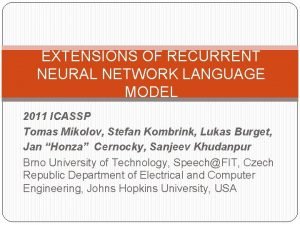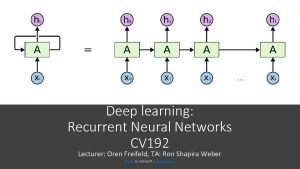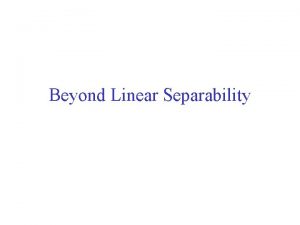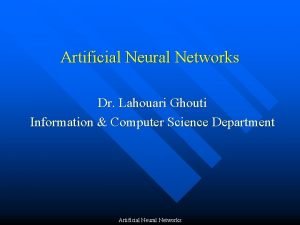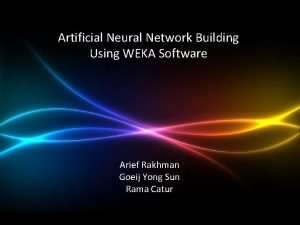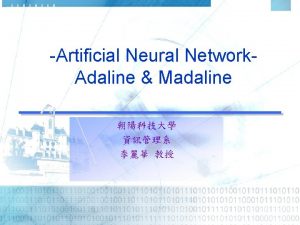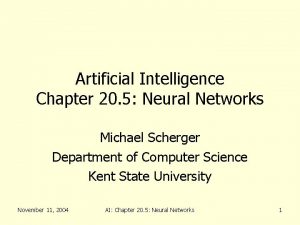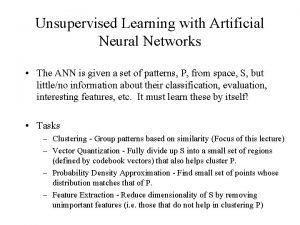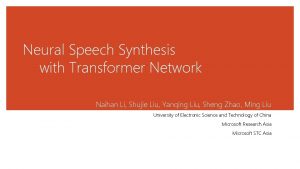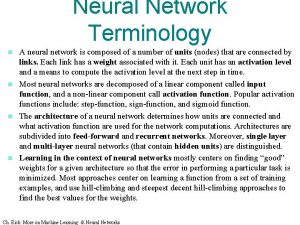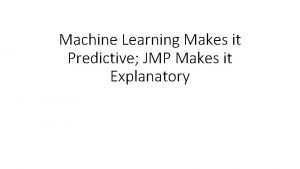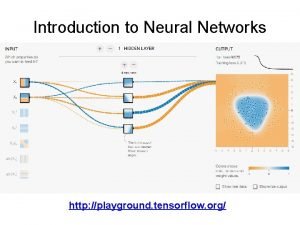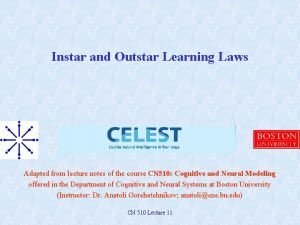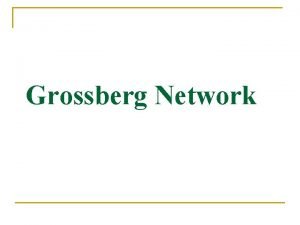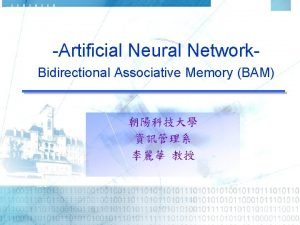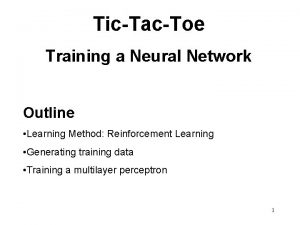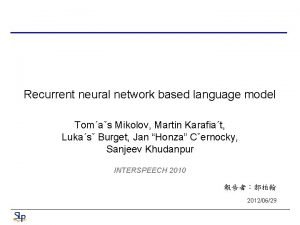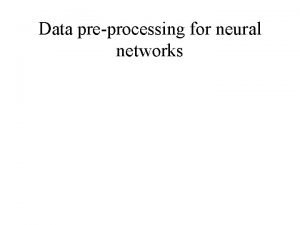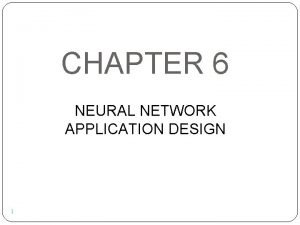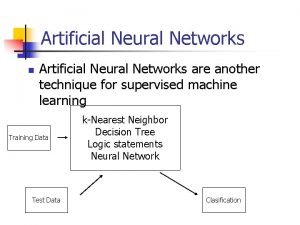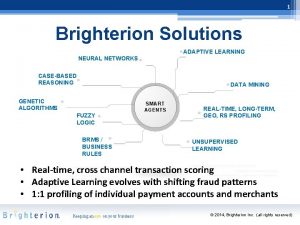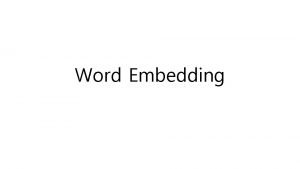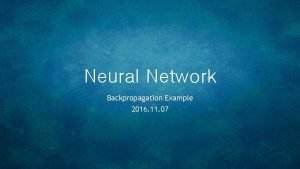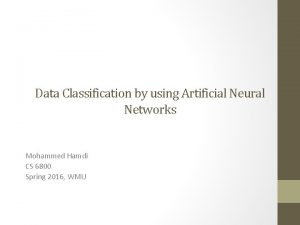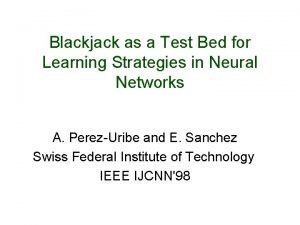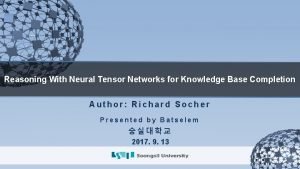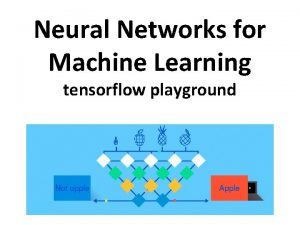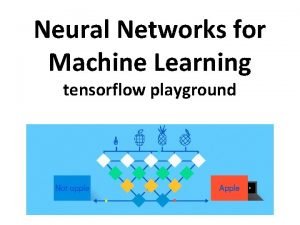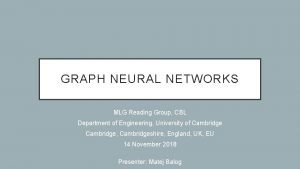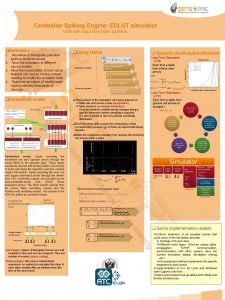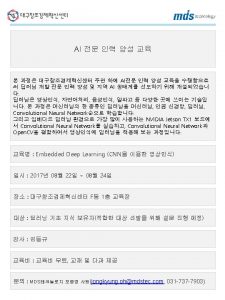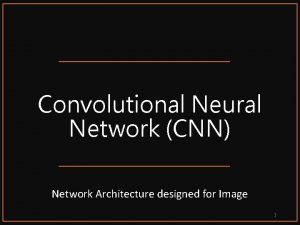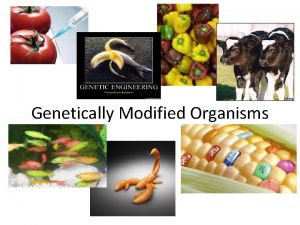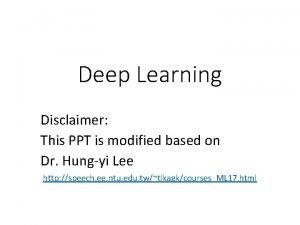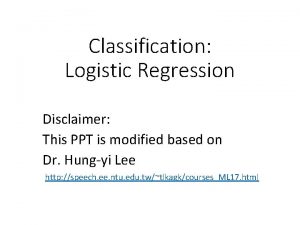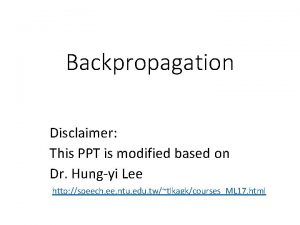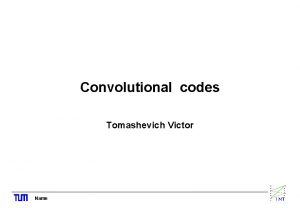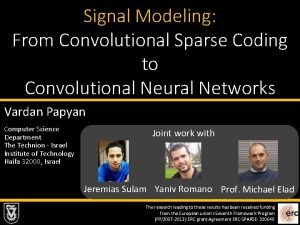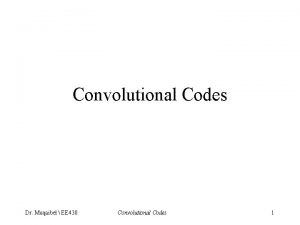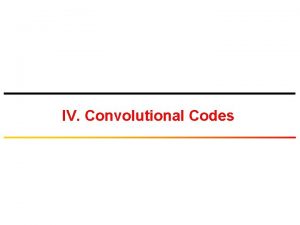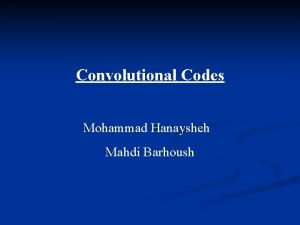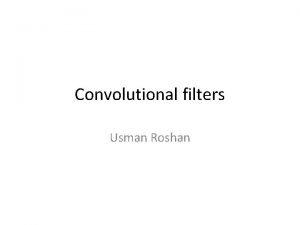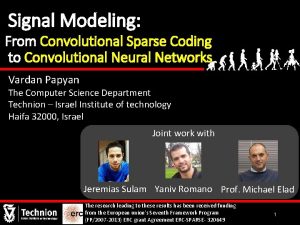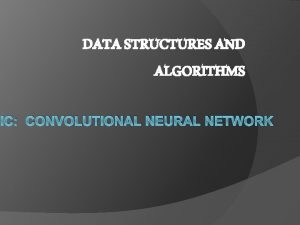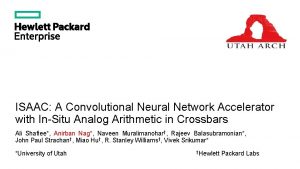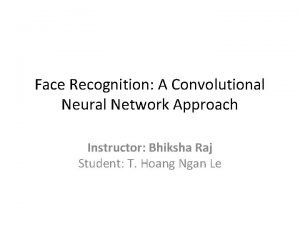Convolutional Neural Network Disclaimer This PPT is modified























































- Slides: 55

Convolutional Neural Network Disclaimer: This PPT is modified based on Hung-yi Lee http: //speech. ee. ntu. edu. tw/~tlkagk/courses_ML 17. html Can the network be simplified by considering the properties of images?


Why CNN for Image • Some patterns are much smaller than the whole image A neuron does not have to see the whole image to discover the pattern. Connecting to small region with less parameters “beak” detector

Why CNN for Image • The same patterns appear in different regions. “upper-left beak” detector Do almost the same thing They can use the same set of parameters. “middle beak” detector

Why CNN for Image • Subsampling the pixels will not change the object bird subsampling We can subsample the pixels to make image smaller Less parameters for the network to process the image

The whole CNN cat dog …… Convolution Max Pooling Fully Connected Feedforward network Convolution Max Pooling Flatten Can repeat many times

The whole CNN Property 1 Ø Some patterns are much smaller than the whole image Property 2 Ø The same patterns appear in different regions. Property 3 Convolution Max Pooling Convolution Ø Subsampling the pixels will not change the object Flatten Max Pooling Can repeat many times

The whole CNN cat dog …… Convolution Max Pooling Fully Connected Feedforward network Convolution Max Pooling Flatten Can repeat many times

CNN – Convolution 1 0 0 1 0 0 0 1 0 1 1 0 0 0 1 1 0 0 1 -1 -1 -1 1 Filter 1 -1 -1 -1 Filter 2 Matrix 1 1 1 -1 -1 -1 Matrix …… 6 x 6 image Those are the network parameters to be learned. Each filter detects a small Property 1 pattern (3 x 3).

1 -1 -1 -1 1 CNN – Convolution stride=1 1 0 0 1 0 0 0 1 0 1 1 0 0 0 1 1 0 0 6 x 6 image 3 -1 Filter 1

1 -1 -1 -1 1 CNN – Convolution If stride=2 1 0 0 1 0 0 0 1 0 1 1 0 0 0 1 1 0 0 6 x 6 image 3 Filter 1 -3 We set stride=1 below

CNN – Convolution stride=1 1 -1 -1 -1 1 Filter 1 1 0 0 1 0 0 0 1 0 1 1 0 0 0 3 -1 -3 1 0 -3 0 0 1 1 0 0 -3 -3 0 1 3 -2 -2 -1 6 x 6 image Property 2

-1 -1 -1 CNN – Convolution stride=1 1 0 0 1 0 0 0 1 0 1 1 0 0 0 1 1 0 0 6 x 6 image 1 1 1 -1 -1 -1 Filter 2 Do the same process for every filter 3 -1 -1 -1 -3 -1 1 -1 0 -2 -3 1 -3 -1 Feature -3 Map 0 -1 -2 -2 0 -2 -4 4 x 4 image 1 1 -1 3

CNN – Colorful image -1 -1 11 -1 -1 -1 -1 -1 111 -1 -1 -1 Filter 2 -1 1 -1 Filter 1 -1 -1 -1 11 -1 -1 -1 -1 1 1 0 0 0 0 1 0 11 00 00 01 00 1 0 0 00 11 01 00 10 0 1 1 0 0 1 00 00 10 11 00 0 11 00 00 01 10 0 0 1 0 0 00 11 00 01 10 0 1 0

Convolution v. s. Fully Connected 1 0 0 1 1 -1 -1 -1 0 1 0 -1 1 -1 0 0 1 1 0 0 -1 -1 1 0 0 0 1 0 1 0 convolution image 0 0 0 1 0 0 0 1 1 0 0 0 1 0 0 0 1 0 …… Fullyconnected 1

1 -1 -1 Filter 1 -1 -1 -1 1 0 0 0 1 0 0 1 1 0 0 6 x 6 image Less parameters! 7 0 : 8 1 : 9 0 : 0 10: … 0 1 0 0 3 … 1 0 0 1 1 1 : 2 0 : 3 0 : 4 0 : 13 0 : 0 14 : 15: 1 16: 1 … Only connect to 9 input, not fully connected

1 -1 -1 -1 1 Filter 1 0 0 0 1 0 1 1 0 0 0 1 1 0 0 6 x 6 image Less parameters! 13 0 : 0 14 : 15: 1 16: 1 … Even less parameters! 7 0 : 8 1 : 9 0 : 0 10: -1 … 0 1 0 0 3 … 1 0 0 1 1 1 : 2 0 : 3 0 : 4 0 : Shared weights

The whole CNN cat dog …… Convolution Max Pooling Fully Connected Feedforward network Convolution Max Pooling Flatten Can repeat many times

CNN – Max Pooling 1 -1 -1 -1 Filter 1 1 -1 -1 -1 Filter 2 3 -1 -1 -1 -3 1 0 -3 -1 -1 -2 1 -3 -3 0 1 -1 -1 -2 1 3 -2 -2 -1 -1 0 -4 3

CNN – Max Pooling 1 0 0 1 0 0 0 1 0 1 1 0 0 0 1 1 0 0 6 x 6 image New image but smaller Conv Max Pooling 3 -1 0 3 1 0 1 3 2 x 2 image Each filter is a channel

The whole CNN 3 -1 0 3 1 0 1 3 Convolution Max Pooling A new image Smaller than the original image The number of the channel is the number of filters Convolution Max Pooling Can repeat many times

The whole CNN cat dog …… Convolution Max Pooling A new image Fully Connected Feedforward network Convolution Max Pooling Flatten A new image

3 Flatten 0 1 3 -1 0 3 1 0 1 3 3 Flatten -1 1 0 3 Fully Connected Feedforward network

Conv 2 D in Keras • keras. layers. Conv 2 D(filters, kernel_size, strides=(1, 1), padding='valid', data_format=None, dilation_rate=(1, 1), activation=None, use_bias=True, kernel_initializer='glorot_uniform', bias_initializer='zeros', kernel_regularizer=None, bias_regularizer=None, activity_regularizer=None, kernel_constraint=None, bias_constraint=None)

Only modified the network structure and input format (vector -> 3 -D tensor) CNN in Keras input 1 -1 -1 -1 1 -1 1 Convolution -1 -1 -1 …… There are 25 3 x 3 filters. Max Pooling Input_shape = ( 28 , 1) 28 x 28 pixels 1: black/white, 3: RGB 3 -1 -3 1 3 Convolution Max Pooling

CNN in Keras Only modified the network structure and input format (vector -> 3 -D tensor) 1 x 28 input Convolution How many parameters 9 for each filter? 25 x 26 Max Pooling 25 x 13 How many parameters 225 for each filter? Convolution 50 x 11 Max Pooling 50 x 5

CNN in Keras Only modified the network structure and input format (vector -> 3 -D tensor) input 1 x 28 output Convolution 25 x 26 Fully Connected Feedforward network Max Pooling 25 x 13 Convolution 50 x 11 1250 Flatten Max Pooling 50 x 5

First Convolution Layer • Typical-looking filters on the trained first layer Filter size: 11 x 11 (Alex. Net) http: //cs 231 n. github. io/understanding-cnn/

How about higher layers? • Which images make a specific neuron activate Ross Girshick, Jeff Donahue, Trevor Darrell, Jitendra Malik, “Rich feature hierarchies for accurate object detection and semantic segmentation”, CVPR, 2014

What does CNN learn? The output of the k-th filter is a 11 x 11 matrix. Degree of the activation of the k-th filter: x input 25 3 x 3 Convolution filters (gradient ascent) 11 11 Max Pooling -1 -3 1 …… -3 …… -1 3 -2 …… …… …… -1 …… 3 50 3 x 3 Convolution filters 50 x 11 Max Pooling

What does CNN learn? The output of the k-th filter is a 11 x 11 matrix. Degree of the activation of the k-th filter: input 25 3 x 3 Convolution filters (gradient ascent) Max Pooling 50 3 x 3 Convolution filters 50 x 11 Max Pooling For each filter

What does CNN learn? input Convolution Find an image maximizing the output of neuron: Max Pooling Convolution Max Pooling flatten Each figure corresponds to a neuron

What does CNN learn? input Can we see digits? 0 1 2 Convolution Max Pooling 3 4 5 flatten 6 7 8 Deep Neural Networks are Easily Fooled https: //www. youtube. com/watch? v=M 2 Ieb. CN 9 Ht 4

What does CNN learn? Over all pixel values 0 1 2 3 4 5 6 7 8

Karen Simonyan, Andrea Vedaldi, Andrew Zisserman, “Deep Inside Convolutional Networks: Visualising Image Classification Models and Saliency Maps”, ICLR, 2014

Karen Simonyan, Andrea Vedaldi, Andrew Zisserman, “Deep Inside Convolutional Networks: Visualising Image Classification Models and Saliency Maps”, ICLR, 2014

Reference: Zeiler, M. D. , & Fergus, R. (2014). Visualizing and understanding convolutional networks. In Computer Vision–ECCV 2014 (pp. 818 -833)

CNN Deep Dream Modify image • Given a photo, machine adds what it sees …… CNN exaggerates what it sees http: //deepdreamgenerator. com/

Deep Dream • Given a photo, machine adds what it sees …… http: //deepdreamgenerator. com/

Deep Style • Given a photo, make its style like famous paintings https: //dreamscopeapp. com/

Deep Style • Given a photo, make its style like famous paintings https: //dreamscopeapp. com/

Deep Style A Neural Algorithm of Artistic Style CNN content style https: //arxiv. org/abs/1508. 06576 CNN ?

More Application: Playing Go Network 19 x 19 matrix (image) 19 x 19 vector Black: 1 white: -1 none: 0 Next move (19 x 19 positions) 19 x 19 vector Fully-connected feedforward network can be used But CNN performs much better.

More Application: Playing Go Training: record of 黑: 5之五 previous plays 白: 天元 黑: 五之5 … CNN Target: “天元” = 1 else = 0 CNN Target: “五之 5” = 1 else = 0

Why CNN for playing Go? • Some patterns are much smaller than the whole image Alpha Go uses 5 x 5 for first layer • The same patterns appear in different regions.

Why CNN for playing Go? • Subsampling the pixels will not change the object Max Pooling How to explain this? ? ? Alpha Go does not use Max Pooling ……

More Application: Speech Frequency CNN The filters move in the frequency direction. Image Time Spectrogram

More Application: Text ? Source of image: http: //citeseerx. ist. psu. edu/viewdoc/download? doi =10. 1. 1. 703. 6858&rep=rep 1&type=pdf


To learn more: CS 231 N class • Consider: • Class Website: http: //cs 231 n. stanford. edu/ • PPT: https: //github. com/w-ww/cs 231 n/tree/master/slides • You. Tube playlist: https: //www. youtube. com/playlist? list=PL 3 FW 7 Lu 3 i 5 Jv. HM 8 lj. Yjz. Lf. QRF 3 EO 8 s. Yv

To learn more… • Lecture 5 | Convolutional Neural Networks • http: //cs 231 n. stanford. edu/slides/2018/cs 231 n_2018_lecture 05. pdf • https: //github. com/w-ww/cs 231 n/tree/master/slides • cs 231 n_2018_lecture 05. pdf • You. Tube playlist: • https: //www. youtube. com/watch? v=b. Nb 2 f. EVKe. Eo&t=2858 s

To learn more… • Lecture 6 | Training Neural Networks I • http: //cs 231 n. stanford. edu/slides/2018/cs 231 n_2018_lecture 06. pdf • https: //github. com/w-ww/cs 231 n/tree/master/slides • cs 231 n_2018_lecture 06. pdf • You. Tube playlist: • https: //www. youtube. com/watch? v=w. Eoyx. E 0 GP 2 M

To learn more… • Lecture 7 | Training Neural Networks II • http: //cs 231 n. stanford. edu/slides/2018/cs 231 n_2018_lecture 07. pdf • https: //github. com/w-ww/cs 231 n/tree/master/slides • cs 231 n_2018_lecture 07. pdf • You. Tube playlist: • https: //www. youtube. com/watch? v=_JB 0 AO 7 Qx. SA

To learn more… • Lecture 9 | CNN Architectures • http: //cs 231 n. stanford. edu/slides/2018/cs 231 n_2018_lecture 09. pdf • https: //github. com/w-ww/cs 231 n/tree/master/slides • cs 231 n_2018_lecture 09. pdf • You. Tube playlist: • https: //www. youtube. com/watch? v=DAOcjic. Fr 1 Y

To learn more… • Lecture 13 | Visualizing and Understanding • http: //cs 231 n. stanford. edu/slides/2018/cs 231 n_2018_lecture 13. pdf • You. Tube playlist: • https: //www. youtube. com/watch? v=6 wcs 6 sz. JWMY
 Neural network ppt
Neural network ppt Convolutional neural network alternatives
Convolutional neural network alternatives Convolutional neural network
Convolutional neural network Visualizing and understanding convolutional neural networks
Visualizing and understanding convolutional neural networks Convolutional neural networks for visual recognition
Convolutional neural networks for visual recognition Style transfer
Style transfer Csrmm
Csrmm Netinsights
Netinsights Convolutional neural networks
Convolutional neural networks Convolutional neural networks
Convolutional neural networks Convolutional lstm network
Convolutional lstm network Freed et al (2001 ib psychology)
Freed et al (2001 ib psychology) Neural networks and learning machines 3rd edition
Neural networks and learning machines 3rd edition Student teacher neural network
Student teacher neural network Neural network cost function
Neural network cost function Tlu perceptron
Tlu perceptron Meshnet: mesh neural network for 3d shape representation
Meshnet: mesh neural network for 3d shape representation Pengertian artificial neural network
Pengertian artificial neural network Neural network in r
Neural network in r Matlab u-net
Matlab u-net Spss neural network
Spss neural network Xkcd neural network
Xkcd neural network Extensions of recurrent neural network language model
Extensions of recurrent neural network language model Draw: a recurrent neural network for image generation
Draw: a recurrent neural network for image generation Limitations of perceptron
Limitations of perceptron Artificial neural network in data mining
Artificial neural network in data mining Least mean square algorithm in neural network
Least mean square algorithm in neural network Weka neural network
Weka neural network Difference between adaline and madaline
Difference between adaline and madaline Decision boundary of neural network
Decision boundary of neural network Maxnet neural network
Maxnet neural network Transformer tts
Transformer tts Artificial neural network terminology
Artificial neural network terminology Principal component analysis jmp
Principal component analysis jmp Playground.tensorflow
Playground.tensorflow Instar and outstar in neural network
Instar and outstar in neural network Grossberg neural network
Grossberg neural network Neural network in data mining
Neural network in data mining Auto associative memory
Auto associative memory Vc bound
Vc bound Neural network tic tac toe
Neural network tic tac toe Tomas mikolov
Tomas mikolov Neural network data preprocessing
Neural network data preprocessing Neural network design solution
Neural network design solution Multilayer neural network
Multilayer neural network Adaptive learning neural network
Adaptive learning neural network Nnlm neural network
Nnlm neural network Backpropagation example
Backpropagation example Maxnet neural network
Maxnet neural network Blackjack neural network
Blackjack neural network Matt damon
Matt damon Playground tensor
Playground tensor A neural network playground
A neural network playground Rnn
Rnn Graph neural network lecture
Graph neural network lecture Edlut
Edlut


